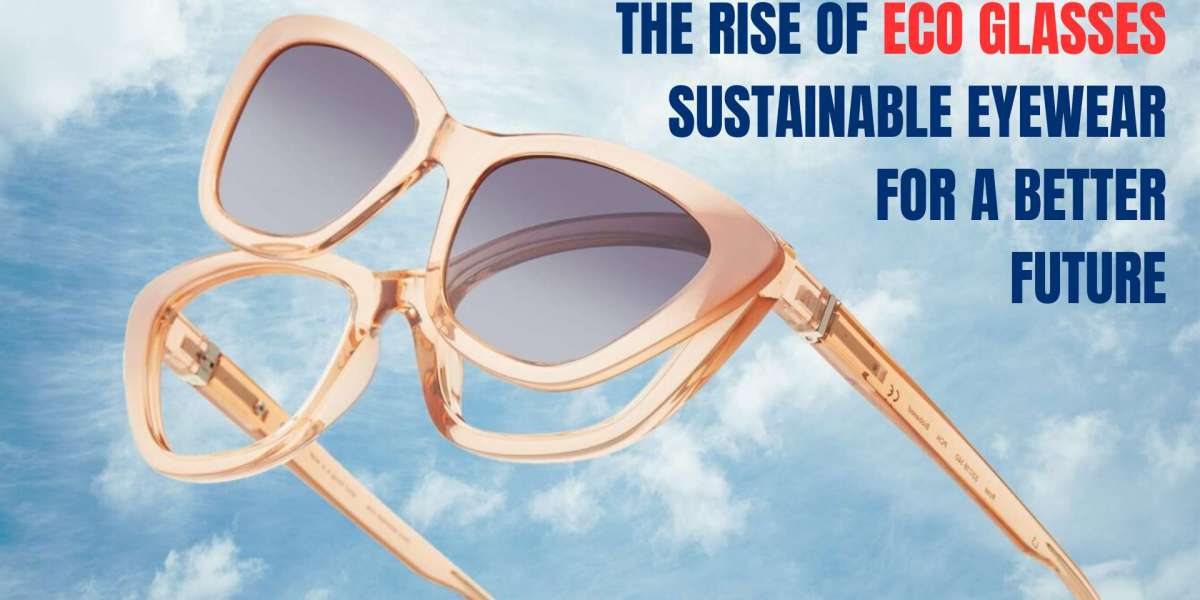As environmental consciousness continues to grow, consumers are becoming more aware of the impact their choices have on the planet. Sustainability is no longer just a buzzword but a movement shaping industries worldwide. The fashion industry, including the eyewear sector, is embracing this shift toward eco-friendly products. Among the most exciting developments in this realm is the rise of eco-friendly glasses—sustainable eyewear designed to reduce waste and environmental harm while offering style and function.
In this article, we’ll explore the growing trend of eco-friendly glasses, why sustainable eyewear is important for the environment, and how consumers can make informed decisions to support a greener future.
1. Why Sustainable Eyewear Matters
The eyewear industry, like many others in fashion, has traditionally relied on materials and production processes that are harmful to the environment. Many conventional eyeglass frames are made from petroleum-based plastics, which are not biodegradable and contribute to environmental pollution. Additionally, the production process often involves excessive water consumption, energy use, and the release of harmful chemicals into the environment.
With growing awareness of the fashion industry's ecological footprint, consumers are pushing for change. Sustainable eyewear offers a solution by providing eco-conscious alternatives that help reduce the industry's negative impact on the environment.
By choosing eco-friendly glasses, consumers can support companies that are committed to using renewable materials, reducing waste, and implementing environmentally-friendly production processes. This shift in consumer behavior is crucial in promoting a more sustainable future for the planet.
2. What Makes Glasses Eco-Friendly?
Eco-friendly glasses are designed with sustainability in mind from start to finish. Several factors contribute to the eco-friendliness of eyewear, from the materials used to the manufacturing process and packaging. Here’s a breakdown of what makes glasses truly sustainable:
a. Sustainable Materials
One of the key components of eco-friendly eyewear is the use of sustainable materials. Instead of relying on traditional plastic, which is derived from fossil fuels, many brands are turning to more eco-conscious alternatives. Some of the most popular sustainable materials used in eco-friendly glasses include:
- Recycled plastic: Frames made from recycled plastic help reduce waste by repurposing existing materials, rather than creating new ones from scratch.
- Biodegradable acetate: Traditional acetate is a plastic derived from cellulose, but biodegradable acetate breaks down more easily in the environment, leaving less of an ecological footprint.
- Bamboo and wood: Naturally renewable and biodegradable, bamboo and other types of wood are excellent sustainable alternatives to plastic. These materials are also incredibly durable and can offer a unique, natural aesthetic.
- Recycled metal: Some eco-friendly glasses use recycled metals, such as stainless steel and aluminum, which can be repurposed without compromising strength or durability.
By using these materials, eyewear brands can significantly reduce their carbon footprint while producing stylish, durable frames.
b. Eco-Conscious Production Processes
The sustainability of eco-friendly glasses extends beyond the materials to the production process itself. Many brands that focus on sustainability are committed to ethical manufacturing practices, such as:
- Reducing energy consumption: Sustainable eyewear companies often work to reduce energy use in their factories by adopting cleaner, more efficient production methods.
- Minimizing waste: By optimizing their manufacturing processes, eco-conscious companies can reduce the amount of material waste generated during production. Some brands even upcycle waste materials into new products.
- Water conservation: The eyewear production process can be water-intensive. Eco-friendly eyewear brands often invest in technologies that reduce water consumption and recycle water wherever possible.
By adopting these practices, sustainable eyewear brands can further minimize their environmental impact, making their products even more eco-friendly.
c. Sustainable Packaging
Sustainability doesn’t end with the glasses themselves; packaging plays a critical role as well. Eco-conscious eyewear brands often use recyclable or biodegradable packaging materials to ensure that their products remain as sustainable as possible throughout the supply chain.
For instance, instead of plastic cases and bubble wrap, eco-friendly glasses may come packaged in recycled cardboard or biodegradable pouches. Additionally, many brands are shifting to plastic-free packaging to reduce the amount of single-use plastic in the environment.
3. The Benefits of Choosing Eco-Friendly Glasses
Switching to eco-friendly glasses offers several benefits, not only for the planet but also for consumers. Here are some key reasons why making the switch to sustainable eyewear is a smart choice:
a. Reducing Environmental Impact
The most obvious benefit of choosing eco-friendly eyewear is the reduced environmental impact. Traditional eyewear materials, such as plastic and non-biodegradable acetate, take hundreds of years to break down in landfills, contributing to pollution and environmental degradation.
By opting for frames made from recycled, biodegradable, or renewable materials, you’re supporting a production process that is far less damaging to the planet. In addition, sustainable eyewear brands typically focus on reducing energy consumption, water use, and waste, further minimizing their ecological footprint.
b. Supporting Ethical Brands
When you buy eco-friendly glasses, you’re not only making a positive environmental impact but also supporting brands that prioritize ethical practices. Many sustainable eyewear companies adhere to fair labor standards, ensuring that workers in their supply chains are treated fairly and paid a living wage. This is an important aspect of sustainability that goes beyond environmental concerns, helping to promote social responsibility within the fashion industry.
c. Style and Durability
A common misconception is that eco-friendly products sacrifice quality or style. However, many sustainable eyewear brands produce high-quality, fashionable frames that rival their conventional counterparts. From sleek metal frames to bold wooden designs, there’s a wide variety of eco-friendly glasses available to suit every taste.
In fact, some materials used in sustainable eyewear, such as bamboo or recycled metals, are known for their durability and lightweight nature, making them comfortable and long-lasting.
d. Promoting a Circular Economy
Sustainable eyewear brands are often part of the larger movement toward a circular economy, which focuses on reducing waste and keeping products and materials in use for as long as possible. By choosing eco-friendly glasses, you’re contributing to this movement and encouraging companies to embrace more sustainable business models.
For example, some eyewear brands offer recycling programs where customers can return old frames to be repurposed or recycled, reducing waste and promoting a closed-loop system. This ensures that fewer materials end up in landfills and that resources are used more efficiently.
4. How to Choose the Right Eco-Friendly Glasses
With the growing demand for sustainable eyewear, there are now many brands offering eco-friendly options. Here are some tips for choosing the right eco-friendly glasses for you:
a. Research the Brand
Before purchasing a pair of eco-friendly glasses, it’s important to research the brand to ensure their sustainability claims are legitimate. Look for brands that are transparent about their materials, production processes, and sustainability goals. Certifications, such as FSC (Forest Stewardship Council) for wood products or Recycled Content Standards, can also indicate that a brand is committed to sustainable practices.
b. Check the Materials
Pay attention to the materials used in the frames. Are they made from recycled plastic, biodegradable acetate, or renewable resources like bamboo? Choosing frames made from eco-conscious materials is one of the best ways to ensure your glasses are truly sustainable.
c. Consider Durability
Sustainable glasses should not only be eco-friendly but also durable. Opt for materials that are known for their longevity, such as bamboo, stainless steel, or high-quality recycled acetate. Durable glasses will last longer, reducing the need for replacements and minimizing waste.
d. Look for Recycling Programs
Some eco-friendly eyewear brands offer recycling programs, allowing you to return your old frames for recycling or repurposing. This is a great option if you want to ensure that your glasses have as little environmental impact as possible, even at the end of their life cycle.
Conclusion
The rise of eco-friendly glasses is a testament to the growing consumer demand for sustainable fashion and eco-conscious products. By choosing sustainable eyewear, you can help reduce the environmental impact of the eyewear industry while still enjoying stylish, high-quality frames. Whether made from recycled plastic, bamboo, or biodegradable acetate, eco-friendly glasses offer a path toward a more sustainable future. Supporting brands that prioritize ethical production and eco-conscious materials is a powerful way to contribute to a greener, healthier planet—one pair of glasses at a time.







